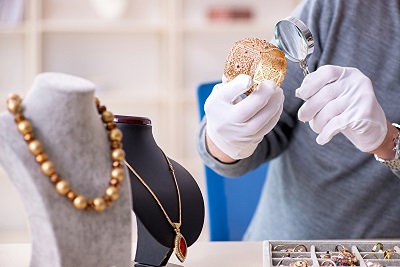Twelve ways to check the authenticity of gold
Gold facts & figures 19.10.2020
 Gold has long been considered an attractive form of investment. Roughly 2,600 years ago, coins of the valuable precious metal were introduced as a standardised payment method – and gold counterfeiting has been around for roughly the same period. Fake gold may come in the form of coins or bullions, containing varying degrees of gold or gold of a lower purity than stated. If purchased from certified precious metal dealers or a bank, there is generally no reason to worry about authenticity. Bargain purchases from less credible dealers on an auction platform or a bazaar, however, are an entirely different story, in which case investors should take a closer look and check for authenticity. There is a wide range of options to do so – from less precise home remedies that can be conducted easily and at little expense to expert tests that require both special know-how and expensive testing equipment. We will show you which methods are particularly suitable and reliable. Irritating and costly disasters may thus be avoided. An example both embarrassing and preventable is that of a German savings bank, which had, without any verification, bought gold bars at an apparent bargain price. They turned out to be fake – previously acquired by the seller on eBay, they had been clearly marked as dummies in the online auction platform’s product description. Better safe than sorry – a motto best also applied to gold purchases.
Gold has long been considered an attractive form of investment. Roughly 2,600 years ago, coins of the valuable precious metal were introduced as a standardised payment method – and gold counterfeiting has been around for roughly the same period. Fake gold may come in the form of coins or bullions, containing varying degrees of gold or gold of a lower purity than stated. If purchased from certified precious metal dealers or a bank, there is generally no reason to worry about authenticity. Bargain purchases from less credible dealers on an auction platform or a bazaar, however, are an entirely different story, in which case investors should take a closer look and check for authenticity. There is a wide range of options to do so – from less precise home remedies that can be conducted easily and at little expense to expert tests that require both special know-how and expensive testing equipment. We will show you which methods are particularly suitable and reliable. Irritating and costly disasters may thus be avoided. An example both embarrassing and preventable is that of a German savings bank, which had, without any verification, bought gold bars at an apparent bargain price. They turned out to be fake – previously acquired by the seller on eBay, they had been clearly marked as dummies in the online auction platform’s product description. Better safe than sorry – a motto best also applied to gold purchases.
Overview of expert and household tests for gold authenticity
| Expert tests | Home remedy tests |
| Acid test | Visual inspection |
| X-ray fluorescence analysis | Comparison of size and weight |
| Ultrasonic analysis | Magnet test |
| Analysis of electrical conductivity | Sound test |
| Bullion DNA Reader | Test template |
| Water displacement test | |
| Verification of authenticity certificates |
How experts check gold for authenticity
Jewellers and gold dealers have a whole arsenal of testing methods at their disposal which can reliably separate the wheat from the chaff, especially when several of them are applied. Tungsten bars coated with real gold are particularly deceptive in appearance and weight, as their density is almost identical to gold. These counterfeits can, however, be detected by experts. For private investors, the expert methods are often not accessible, as they are either too expensive or the risk of damage to the bar or coin is too great. When in doubt, a jeweller can help you check the authenticity with the following methods.
The acid test
The acid test is usually used to test gold jewellery. It can, however, also be used to test coins and bars to verify authenticity and the indicated purity. A specified test acid is used for each degree of fineness, drizzled on the mark created by rubbing the gold (or gold-coloured) test object on a dark stone. If the mark fades upon coming into contact with the acid, there is a high probability that the gold that has left the mark is fake. It should be noted that this method of checking authenticity only tests the surface of an object. The acid test does not detect whether an item is merely gold-plated.
X-ray fluorescence analysis
In this high-tech method, coins or bars are exposed to X-rays and the reflecting X-ray fluorescence radiation is analysed, thus determining the metallic composition of the object under examination as precisely and reliably as possible. As with the acid test, the disadvantage of this quick test method is its limitation to the object’s surface. If the layer of real gold coating a fake bullion is thick enough, the X-ray fluorescence analysis fails.
In-depth analysis via ultrasound
Authenticity testing by ultrasonic analysis goes much deeper than the acid test and X-ray fluorescence analysis. It is based on the fact that different metals have different metal transit times, i.e. the time which ultrasound needs to penetrate the object under examination. Even excellent forgeries, such as the above-mentioned gold bars with tungsten cores, are easily detected.
Analysis of electrical conductivity
All metals, including precious metals and precious metal alloys, conduct electricity to different degrees. Conductivity analysis can therefore determine quite accurately whether the bar or coin in question really is made of the material it claims to be. An advantage over other methods is that gold bars sold in a blister can also be tested without removal of the packaging.
The Bullion DNA Reader for Maple Leaf coins
Only gold dealers who take part in the Royal Canadian Mint’s Bullion DNA programme for the identification of Canadian-made gold, silver, platinum, and palladium coins receive a special reader linked to a database. Using a technology similar to an iris scan, it scans the surface of a Maple Leaf coin and compares it in real time with a surface print from a database in Canada. The database contains the scans of every coin produced since the introduction of the reader. According to the manufacturer, this process is one hundred percent safe, and other coin suppliers might well follow this example.
Authentication via household remedies
Next to professional methods, there are inexpensive and simple ways to test the authenticity of gold bars or coins. The basic knowledge of the gold owners as well as the available possibilities to compare the specimens in question are decisive in the accuracy of the assessment.
Visual inspection
The simplest authenticity check: visual analysis of the object. Particular attention should be paid to the slightest deviation from a demonstrably genuine counterpart. Successful inspection is thus dependent on the availability of a second matching coin or bar. Another, albeit far less ideal, possibility of comparison is via product images from online shops. Is the appearance of the gold identical to the product images or are deviations detectable? Are the coins’ edges grooved or smooth? Are the sides of the bullions damaged or otherwise conspicuous? Rough differences can thus be detected, but more intricate counterfeits are harder to recognise. For laypersons, this method is therefore suitable only to a very limited extent.
Size and weight
Checking the size and weight of an object is also easy. It is also much more telling than a visual inspection, and particularly worthwhile for coins, as the specific weight for each common bullion coin is readily available. The Vienna Philharmonic gold coin, for example, is exactly 37.0 mm in diameter and is 2.0 mm thick, at a weight of exactly 31.103 g. If one of these values deviates, the coin is most likely a gold-plated fake with a copper-silver alloy core.
Magnet test
Gold is diamagnetic, i.e. it is not attracted but repelled by magnets. The test requires a strong magnet, but be careful – test the magnetic effect beforehand. The magnet is held against the bullion or the coin. If the magnet sticks to the object to be tested, it is definitely not pure gold. So-called magnetic scales offer more reliable results than simple magnets. One advantage of the magnet test is that it can also be applied to gold in blister packs. By contrast, the magnet test is not suitable for gold alloys used in the production of jewellery.
The sound test for gold coins
The authenticity check via sound test works without additional aids. The gold coin to be tested is simply flicked briefly with another metallic object. The clear, distinctive sound of gold differs greatly from that of counterfeits, which sound dull by comparison. This method should only be applied by experienced collectors closely familiar with the sound of gold.
Test templates
A test template, also called a “Fisch” coin detector, is available for every popular investment coin, such as the American Eagle or Krugerrand. The gauge allows even laypersons to quickly and relatively reliably verify the authenticity of a coin by checking its dimensions and detecting even the slightest deviations. The test instruments are suitable for various common bullion coins and available for under €50. Their disadvantage: very good counterfeits pass this authenticity test.
Density check via water displacement
This test method has been around for a very long time: the Greek mathematician and physicist Archimedes developed it in the 3rd century BC. The density of the bar or coin in question is determined by immersing it and measuring the resulting displacement of water. Archimedes discovered that every metal has a specific weight; that of 24 carat gold with a fineness of 999.9/1000 is 19.3 g/cm3. A great advantage of this method is that, in addition to authenticity, the fineness of gold can also be reliably determined. However, extreme accuracy is required: even the water temperature must be exactly 20° Celsius, because it is only then that the density of the water is exactly 1 g/cm3. In addition, the test object must also be completely smooth all around, as even the smallest water bubbles can influence the measurement result. Detailed instructions on how to conduct the water displacement test to produce a reliable result can be found on the Internet.
Certificates of authenticity
The Good Delivery Standard of the London Bullion Market Association, established in 1987, is the most important quality seal for gold bar manufacturers. The standard includes strict specifications for the dimensions, weight, appearance, stamping, and fineness of gold bars, which must be at least 995.0/1000. In addition, the bullion producer must also meet certain quality criteria. The Good Delivery certificate is recognised worldwide and makes it easier for investors to resell gold bars.
The blister packs which gold bars are wrapped in also have certificates issued by the manufacturer to show the authenticity of the bullion.
Unfortunately, blister packaging can also be forged, as can be the printed certificates. This may seem frustrating, but it is actually an additional opportunity: counterfeiters often place less effort in copying the imprints on the blister packs than they do on the bars themselves. On closer inspection, it is therefore possible for experts – and sometimes for laypersons – to detect imperfectly copied certificates and other imprints on the blisters and thus identify fakes. This of course depends on the availability of a definitely genuine object for comparison.
Our recommendation: Buy gold coins and bars from renowned dealers
While the expert tests all at least allow for a reliable surface analysis, and the ultrasonic and electrical conductivity analysis both ensure one hundred percent safety, most household remedies are merely superficial. Even laypersons can, however, improve the reliability of their test results by combining several methods, especially if they include the packaging in their inspection. At least relatively poor counterfeits, where the core of a bar or coin is copper and silver, can be exposed quite reliably. For tungsten fakes, all detection methods fail except the water displacement test, in which effectiveness depends on extreme accuracy.
Basically, all of the above-mentioned methods of authentication have one disadvantage in common: the purchase has already been made. If the object turns out to be a fake, the buyer is not automatically reimbursed.
The easiest and safest way to avoid falling for fake gold: buy from a reputable, certified gold dealer or from your local bank.
Xetra-Gold Hotline

Do you have questions? We have the answers. Contact us here: 9 a.m.–6 p.m. CET
xetra-gold(at)deutsche-boerse.com
For press inquiries: media-relations(at)deutsche-boerse.com




